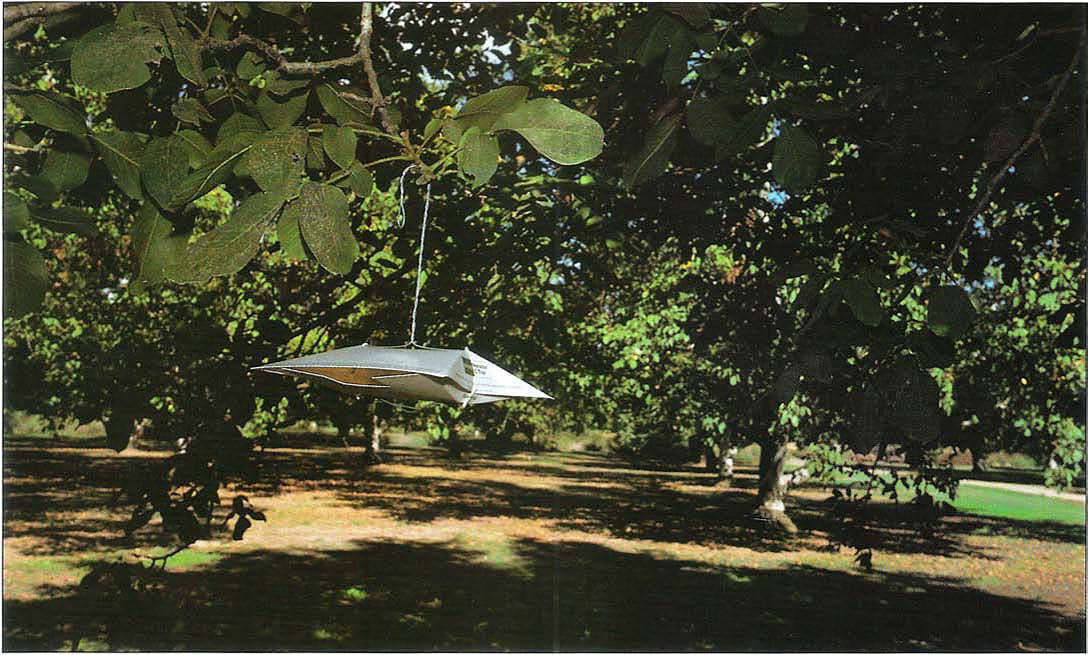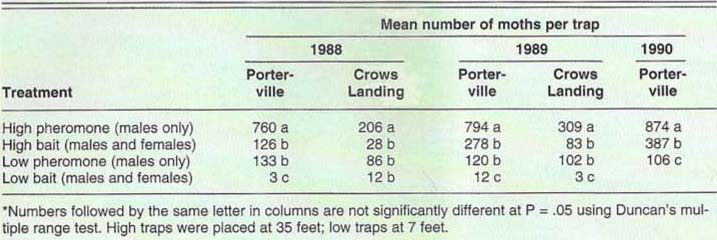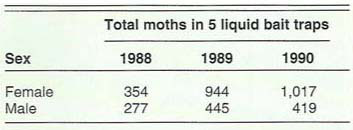All Issues
Codling moth, navel orangeworm studies show knowing location of pests in walnuts should help disrupt mating, egg laying
Publication Information
California Agriculture 47(3):13-15.
Published May 01, 1993
PDF | Citation | Permissions
Abstract
In flight, codling moths prefer upper tree strata, whereas navel orangeworm oviposition is more evenly distributed throughout the tree. Pest monitoring and pheromone placement for mating disruption should recognize the vertical distribution of these insects in walnut trees.
Full text
Navel orangeworm, Amyelois transitella (Walker), is a major economic lepidopteran pest infesting walnuts in California. Because navel orangeworm cannot infest sound, uninjured nuts, the principal components of its management are orchard sanitation to reduce overwintering populations, prompt harvest and protection of the crop from in-season hull damage, including walnut blight, sunburn and codling moth [Cydia pomonella (L)] infestation. The in-season codling moth control program is especially critical to effectively managing navel orangeworm in walnut orchards.
Controlling codling moth requires careful appraisal of population size and adult flight to determine the need and timing for chemical treatment. Until late in the 1970s, growers used methods described in a 1932 UC Extension circular by Arthur Borden. Male and female populations and flight activity were monitored with “liquid bait traps,” that is, buckets or deep pans filled with a solution containing malt (diamalt) and water or, more recently, terpinyl acetate, brown sugar and water. Bait traps were placed in the upper one-fourth to one-third of the walnut tree canopy (20 to 30 feet aboveground) and inspected once or twice a week for the presence of adult moths.
Although effective, liquid bait traps were cumbersome and messy. Trapping has since become more efficient and easier with use of a synthetic formulation of the female codling moth pheromone to attract male moths. For 15 years, sticky traps placed 6 to 8 feet up in the tree and baited with the pheromone have been used to monitor adult males in sensitive crops, including walnut, as indicators of population activity.
TABLE 1. Adult codling moth catch during 1988, 1989 and 1990 in Porterville and Crows Landing walnut orchards*
Accurate insect monitoring requires placing traps in the greatest population density. Codling moth flight activity is concentrated in the upper portions of apple and pear trees (according to Riedl and associates, see reference at end of text). Compared with walnut trees, apple and pear are relatively small, especially in high-density orchards utilizing dwarf rootstocks. Therefore, pheromone traps placed 6 to 8 feet high are adequate for measuring codling moth flight activity. Similar pheromone trap placement had also been recommended for walnut (see Integrated Pest Management for Walnuts, UC publication 3270) even though no data exist to suggest codling moth flight and population density can be adequately detected low in the tree or that trap counts there would accurately represent population activity.
In contrast, Borden recommended that liquid bait traps be placed in the upper canopy of walnut trees, assuming most codling moth activity occurred there. Because walnut trees are larger than apple and pear, knowledge of the vertical distribution of codling moth flight activity and height-related population density in walnuts would help determine whether better pheromone trap placement opportunities exist. Furthermore, knowledge of such distribution would assist future implementation of technologies that utilize synthetic pheromones to disrupt codling moth flight activity and mating where they are at their greatest.
Navel orangeworm is monitored by attracting female moths to an “egg trap” that simulates an oviposition site (see California Agriculture, March-April 1977). The standard egg trap is a 25-dram plastic vial with two large windows cut from the sides and openings, and covered with 160-mesh polyester organdy. It is painted black and filled with almond press-cake and crude almond oil to simulate ripening almonds, an attractive host for this pest. Egg deposition is counted regularly to determine activity. Integrated Pest Management for Walnuts implies that navel orange-worm egg traps should also be placed low in the tree, even though, again, no data exist on this pest's vertical distribution within walnut trees.
Here we report results of experiments designed to delineate the vertical distribution of codling moth flight and navel orangeworm egg laying in large walnut trees.
Methods
In 1988, we selected experimental walnut orchards with histories of moderate codling moth and navel orangeworm infestation at two sites: (1) Porterville (Tulare County) in the southern San Joaquin Valley, characterized by warm springs and hot summers, and (2) Crows Landing (Stanislaus County) in the Central Valley walnut district, where cooler, windier spring weather and more moderate summer temperatures are normal.
The Porterville orchard was a 20-acre block of mature, 50-foot-tall ‘Serr’ walnut trees, spaced 28 feet x 28 feet (approximately 56 trees per acre). The Crows Landing orchard had 30 acres of mature, 40-foot-tall ‘Payne’ walnut trees spaced 30 feet x 30 feet (approximately 48 trees per acre). For the experiment, each orchard was divided into five equal blocks (replications), 4 acres per block (Porterville orchard) and 6 acres per block (Crows Landing orchard).
Codling moth flight and navel orangeworm oviposition activity were measured as follows:
Codling moth flight activity
In each experimental block in each orchard, one Pherocon 1CP winged sticky trap (manufactured by Tréce Inc.) and one bait trap, a 1-gallon bucket containing liquid bait, were randomly placed within each block at 35-foot and 7-foot heights, spaced no closer than 200 feet apart to avoid intertrap influence. The pheromone traps were baited with a single rubber septa impregnated with 1 mg of the commercial codling moth pheromone, “Codlemone” (E8, E10-dodecadienol, manufactured by Tréce Inc.), and the bait traps with a solution of terpinyl acetate, brown sugar and water (2.5 ml:1 lb:5 qt). The pheromone was replaced at 4-week intervals and new bait added as needed to maintain the original liquid level. Sticky bottoms of the pheromone traps were replaced before each codling moth flight or as debris accumulated to the point where moth catch would be impaired.
All traps were monitored for adult moths twice weekly from the beginning of March, before adult flight of any overwintered codling moth, through three seasonal generations until adult flights diminished to negligible levels in early to mid-September. Flight activity was measured in 1988 and 1989 in both locations to determine the vertical distribution of codling moths within the trees. In 1990, the experiment was continued only in the Porterville walnut orchard and was modified to exclude the 7-foot bait trap due to low trap catches detected previously. Trapping dates in Porterville were: March 14 to October 7, 1988; February 28 to September 1, 1989, and March 7 to September 14, 1990. Trapping dates in Crows Landing were: March 14 to October 3, 1988, and February 28 to September 8, 1989. In all years, trap catches were totaled and the mean number of moths caught per trap determined. Data were analyzed by ANOVA and means separated using Duncan's multiple range test at P = .05 or P = .01.
Navel orangeworm oviposition
Ten standard navel orangeworm egg traps, painted black (manufactured by Tréce Inc.) and baited with mixed almond press-cake and crude almond oil (9:1 by weight), were randomly hung throughout the Porterville orchard at 7 feet and 35 feet in 1989 and 1990. In 1991, eight navel orangeworm traps were similarly placed in the orchard. Eggs were counted and removed from each trap twice weekly. Egg deposition was totaled for each trap at high and low placement within the tree and the mean number of eggs per trap analyzed by ANOVA.
Codling moth flight
Pheromone traps versus liquid bait traps
Pheromone traps consistently outperformed liquid bait traps at high and low locations in each orchard each year of the experiment. Mean number of moths caught per trap was significantly higher for pheromone traps than for liquid bait traps at either height in the Porterville orchard each year. At Crows Landing, pheromone trap catches were significantly higher than bait trap catches except for the low position 1 year of the experiment (table 1).
Effect of trap placement
Adult codling moth trap catches were significantly greater at 35 feet than at 7 feet in each test location each year, regardless of trap type (table 1).
With pheromone traps, in the Porterville orchard, five to six times more male moths were caught at 35 feet than at 7 feet. In the Crows Landing orchard, two to three times more males were caught high than low in pheromone traps.
Liquid bait traps were also more effective when placed at a height of 35 feet than at 7 feet; significantly more moths were caught at 35 feet than at 7 feet each year in the Porterville orchard and in 1 of the 2 experimental years in the Crows Landing orchard (table 1). Liquid bait traps placed at 7 feet caught such low numbers of moths that they were essentially useless in monitoring codling moth and were omitted from the comparison in the Porterville orchard in 1990.
Sex of adult codling moths caught in the liquid bait traps placed at 35 feet in the Porterville orchard was determined on each count date each year of the study. Higher numbers of females, approximately twice as many, were caught than males each year, clearly demonstrating that females were present in the tree tops (table 2). No observation of mating was made in this study; however, these data suggest strong potential that mating may occur in the tree tops.
Navel orangeworm oviposition
Unlike adult codling moth flight activity, a consistent vertical difference in navel orangeworm egg-laying activity did not occur between 7 feet or 35 feet (table 3, fig. 1). No significant difference in egg-laying activity occurred due to trap height in either 1989 or 1991. In 1990, traps placed at 7 feet had significantly more eggs laid on them than those at 35 feet. However, the major contribution to significance was the last generation, which may have been influenced by an air application of insecticide applied in late August. We also observed that peaks of navel orangeworm oviposition in these studies were not as distinct or as pronounced as those detected previously in almonds, probably because of differences in navel orangeworm populations. From these data we believe black egg traps placed at approximately 7 feet appear to adequately represent navel orangeworm activity in most orchards, keeping in mind that inadequate spray coverage by air or ground for codling moth may alter where navel orangeworm oviposition will primarily occur in very tall trees. Our experience would indicate that, in such situations, placement of both low and high navel orangeworm egg traps needs reevaluation.
Discussion
As with apple and pear trees, codling moth flight activity is considerably more intense in the upper stratum of walnut trees than at 7 feet. This information is valuable for two reasons:
(1) Mating disruption
Control of codling moth by mating disruption requires that the synthetic pheromone blankets areas of the tree where mating occurs. Our data conclusively demonstrate that flight activity is greatest in the tree tops. Pheromone dispensers developed for mating disruption should be placed in the upper canopy to be most effective.
(2) Trap placement
Placement of pheromone traps high in the tree canopy, rather than at currently recommended lower levels, could improve monitoring of codling moth populations and their potential for damage. This may be especially true in orchards where only moderate populations exist and control decisions must be based on ambiguous catch numbers from low traps, as in the Crows Landing orchard (table 1).
Furthermore, when a synthetic pheromone is developed and used for mating disruption, liquid bait traps placed high in trees may help monitor treatment efficacy by evaluating the presence of adult moths and the mating status of females. In our initial mating disruption studies (Walnut Marketing Board Walnut Research Reports, 1989 and 1990), male and female adult codling moth catches in liquid bait traps were not affected by the applied pheromone, whereas male catches in standard pheromone traps were essentially nil. (For more information, see Riedl, H., J. E. Howell, P. S. McNally, and P. H. Westigard. 1986. Codling Moth Management — Use and Standardization of Pheromone Trapping Systems. University of California, Bulletin 1918.)









